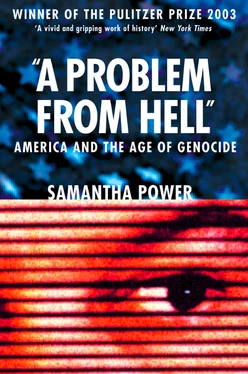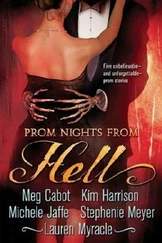But the United States had backed a loser. Lon Nol was pro-American, but like many U.S.-sponsored dictators of the period, he was also corrupt, repressive, and incompetent. He secluded himself in his villa in the Cambodian capital of Phnom Penh and remained woefully out of touch with the affairs of his state. He depended on the mystical advice of a visionary monk named Mam Prum Moni, or “Great Intellectual of Pure Glory.”The only assertive moves Lon Nol made were those designed to increase his own power. He stripped citizens of basic freedoms, suspended parliament, and announced in October 1971 that it was time to end “the sterile game of outmoded liberal democracy.” In 1972 he declared himself president, prime minister, defense minister, and marshal of the armed forces. The United States cared only that Lon Nol was a staunch anti-Communist. The United States spent some $1.85 billion between 1970 and 1975 propping up his regime—evidence, in President Nixon’s words, of “the Nixon Doctrine in its purest form.” 12
The U.S. ground invasion of April 1970 occurred at the beginning of Cambodia’s five-year civil war, a merciless war that the genocidal Khmer Rouge would win. On one side were Lon Nol and the United States. On the other side stood the Vietnamese Communists and the small, mysterious group of radical Cambodian Communist revolutionaries. The leaders of the Khmer Rouge, or Red Khmer, had been educated in Paris, studied Maoist thought, and received extensive political and military support from China. They were youths who had been driven to Communist resistance out of frustration with Prince Sihanouk’s earlier, authoritarian rule. Under the leadership of Saloth Sar, who later assumed the pseudonym Pol Pot, they had left Cambodia’s cities in the 1960s to plot revolution from the Cambodian and Vietnamese countryside. 13It had been Sihanouk’s tyranny that drove them to arms, but when Lon Nol seized power in the 1970 coup, the KR began fighting Lon Nol’s government forces instead and made their former nemesis Prince Sihanouk the figurehead leader of an unlikely coalition. This earned them support from the millions of Cambodians who trusted Sihanouk, the likable man who had brought them independence. Although doubts emerged in 1973 and 1974 about whether the more moderate Sihanouk spoke for the KR, Cambodians trusted his judgment. “I do not like the Khmer Rouge and they probably do not like me,” the prince said in 1973. “But they are pure patriots…Though I am a Buddhist, I prefer a red Cambodia which is honest and patriotic than a Buddhist Cambodia under Lon Nol, which is corrupt and a puppet of the Americans.” 14
Even backed by the United States, the Lon Nol regime did not stand much of a chance in battle. Its forces were equipped for parades, not warfare. 15In 1972 Lon Nol famously had airplanes sprinkle blessed sand around Phnom Penh’s perimeters to ward off his ungodly Communist enemies. Lon Nol’s officers exaggerated Cambodian army troop strength, listing phantom troops and using U.S. aid to pad their pockets, stuff foreign bank accounts, and build themselves glamorous homes. Regular army soldiers, by contrast, frequently went unpaid and deserted. And though the Cambodian army enjoyed a huge numerical edge over the rebels, many were unenthusiastic about fighting on behalf of Lon Nol. Those who did fight were dependent on U.S. bombing and, later, U.S. military aid.
U.S. interest in Cambodia during the civil war was completely derivative of U.S. designs on Vietnam. So when U.S. troops withdrew from Vietnam in January 1973, the bombing of Cambodia became harder to justify. In August 1973 Congress finally stepped in to ban the air campaign. President Nixon was furious. He blamed Congress for weakening regional security and “raising doubts in the mind of both friends and adversaries” about U.S. “resolve.” All told, between March 1969 and August 1973, U.S. planes dropped 540,000 tons of bombs onto the Cambodian countryside. 16The United States continued to supply military and financial assistance to Lon Nol, warning that a “bloodbath” would ensue if the KR were allowed to triumph.
The U.S. B-52 raids killed tens of thousands of civilians. 17Villagers who happened to be away from home returned to find nothing but dust and mud mixed with seared and bloody body parts. Lon Nol’s ground forces used massive heavy artillery barrages to pacify areas or villages where some enemy activity was suspected. By 1973, inflation in Cambodia topped 275 percent, and 40 percent of roads and one-third of all bridges had been rendered unusable. 18With the local economy dysfunctional, U.S. aid came to count for 95 percent of all of Lon Nol’s income.
The U.S. bombing did little to weaken the Vietnamese or the Cambodian Communists. Instead, it probably had the opposite effect. Cambodians who resented America’s demolition derby were captive both to the promise of peace and the anti-Americanism of the Khmer Rouge. British journalist William Shawcross and others have argued that the Khmer Rouge ranks swelled primarily because of the U.S. intervention. Chhit Do, a Khmer Rouge leader from northern Cambodia who later defected, described the effect of U.S. bombing:
Every time after there had been bombing, they would take the people to see the craters, to see how big and deep the craters were, to see how the earth had been gouged out and scorched…The ordinary people…sometimes literally shit in their pants when the big bombs and shells came…Their minds just froze up and they would wander around mute for three or four days. Terrified and half-crazy, the people were ready to believe what they were told…That was what made it so easy for the Khmer Rouge to win the people over…It was because of their dissatisfaction with the bombing that they kept on cooperating with the Khmer Rouge, joining up with the Khmer Rouge, sending their children off to go with them. 19
Prince Sirik Matak, once a Lon Nol ally, warned U.S. officials not to back the unpopular Lon Nol regime. “If the United States continues to support such a regime,” he warned, “you help the Communists.” 20American intervention in Cambodia did tremendous damage in its own right, but it also indirectly helped give rise to a monstrous regime.
The Unknowable Unknown
Before it begins, genocide is not easy to wrap one’s mind around. A genocidal regime’s intent to destroy a group is so hideous and the scale of its atrocities so enormous that outsiders who know enough to forecast brutality can rarely bring themselves to imagine genocide. This was true of many of the diplomats, journalists, and European Jews who observed Hitler throughout the 1930s, and it was certainly true of diplomats, journalists, and Cambodians who speculated about the Khmer Rouge before they seized power. The omens of imminent, mass violence were omnipresent but largely dismissed.
Before the fall of Phnom Penh in April 1975, Cambodia’s Communists were well enough known to cause some Americans alarm. In June 1973 Kenneth Quinn, a thirty-two-year-old U.S. foreign service officer, was introduced to the Khmer Rouge quite by accident. For six years, he had worked in Vietnam as an American provincial adviser, and he had spent his last two years posted in Chou Doc, the Vietnamese province bordering Cambodia on the Mekong River. One day, Quinn hiked up a mountain outside Chou Doc that allowed him to survey the terrain for 10 miles around. In scanning the Cambodian horizon, he encountered a scene that both stunned and chilled him. “The villages in Cambodia are clustered in circles,”Quinn recalls. “When I looked out, I saw that every one of these clusters was in flames and there was black smoke rising from each one. I didn’t know what was going on. All I knew was that as far as the eye could see, every single village in Cambodia was on fire.”
Читать дальше












